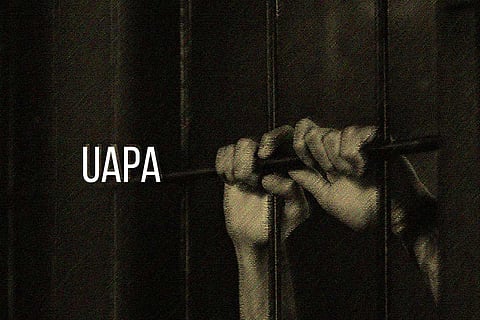

A total of 8,371 persons were arrested in 5,924 cases under the draconian Unlawful Activities Prevention Act (UAPA) across India between 2015 and 2020, according to a report by the People's Union for Civil Liberties (PUCL), which sheds light on the Union government’s alleged abuse of the anti-terror law and calls to repeal it. In the same period, however, only 235 persons were convicted under the UAPA. The report, which examines data from the National Crimes Records Bureau (NCRB) and the National Investigation Agency (NIA) website, demonstrates that a significant number of the people arrested under UAPA were involved in cases where no specific incidents of violence were reported. It also found that a very large number of people arrested under UAPA were acquitted after being jailed for years. The report calls for the disbanding of the NIA and demands the immediate release of all political prisoners on bail.
The report, titled ‘UAPA: Criminalising Dissent and State Terror: Study of UAPA Abuse in India, 2009 - 2022’, looks at NCRB data from 2015-2020, and case information on the NIA website from 2009 – when the organisation was formed in the aftermath of the 2008 Mumbai terror attack – to August 12 this year. While the NIA website listed a total of 456 cases handled by it, 78% (357 cases) of them involved UAPA charges.
Across the country, the fourth highest number of UAPA cases handled by NIA were registered in Kerala (27), while Karnataka (13), Tamil Nadu (13) and Andhra Pradesh (12) had fewer cases. Of the 357 UAPA cases handled by NIA, 69 were registered when the Manmohan Singh–led United Progressive Alliance (UPA) regime was in power (from 2009 to May 2014), whereas 288 cases (around 80%) were registered under the Narendra Modi-led National Democratic Alliance (NDA) regime.
Moreover, of the 357 cases, 41 cases (12%) were registered suo motu by the NIA, while 316 cases or 88% were transferred from state investigating agencies to the NIA by the intervention of the Union Ministry of Home Affairs. These include the Bhima Koregaon case, which was transferred to NIA from the Maharashtra police shortly after the change of regime in the state, from the BJP-led government under former CM Devendra Phadnavis to the Maharashtra Vikas Aghadi (MVA)-led government headed by Shiv Sena’s Uddhav Thackeray, the report points out.
It also cites the example of the 2021 Munchingiputtu case in Andhra Pradesh, and a Madurai case of a man booked over an Independence Day Facebook post. “This unbridled power in the hands of the Central government enabling the NIA to take over any state investigation, not only paves way for political interference but most importantly undermines the very structure of federalism,” the PUCL report says.
In the 357 UAPA cases handled by NIA, the most commonly invoked offence was Section 18 (punishment for conspiracy) of UAPA with 238 cases involving this offence. This was followed by Section 20 (punishment for being member of terrorist gang or organisation), Section 16 (punishment for terrorist act), and others. The PUCL report notes that the offence of conspiracy is very widely defined, and “[such] over broad, sweeping and loosely worded provisions obviously permits arbitrary use of its provision to rope in anyone the police want to implicate in any case”. It calls for framing appropriate criteria to classify undertrial prisoners in existing UAPA cases, and to recommend consideration of their cases for granting bail, to reduce the severity of the incarceration and the load on individuals unnecessarily implicated under UAPA charges.
The report also divides these 238 conspiracy cases into two categories, based on whether an incident of actual violence inflicting physical injury or property damage with the use of weapons was reported or not. No such incidents were reported in 64% (152) of the cases, the report found. It alleges that the police often abuse this law, besides adding, “At its core, the UAPA is a political legal weapon at the hands of the state to use at will … Invariably, those against whom the UAPA has been widely used belong to members of the Muslim minority community, political dissenters and activists, those dubbed to be members of extremist groups and so on … [A] mere allegation that a person belongs to a ‘banned or proscribed’ organisation without any supportive evidence, is sufficient to get the person implicated and arrested.”
Based on the NCRB data and replies to Lok Sabha questions, the percentage of UAPA accused on bail (number of persons granted bail in a year/number of persons arrested that year*100) was only 16.32% in 2018, 32.08% in 2019 and 16.88% in 2020. Conviction rates too were found to be abysmally low. Overall, from 2015 to 2020, the conviction rate based on the number of cases (where at least one of the accused persons is convicted) was 27.57%. The conviction rate based on persons arrested was only 2.8%. This means around 97.2% of those accused in UAPA cases are often jailed for long periods and eventually acquitted.
However, the bail and conviction rates, calculated based on NCRB data, are imperfect, as the people granted bail or acquitted in a particular year do not necessarily correspond to the persons arrested in that year. The report also notes other flaws with the data. The NCRB follows the ‘principal offence rule’, where only the principal offence in an FIR – the one with the maximum sentence – is considered. This means that if a person accused of a more severe crime, like murder, has also been slapped with UAPA, the latter is unlikely to show up on the NCRB data, which in turn indicates that there could be a gross undercounting of UAPA cases. It also notes that the information available on the NIA website is neither uniform nor comprehensive, with documents like chargesheets and court judgments missing in some cases.